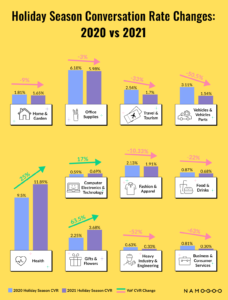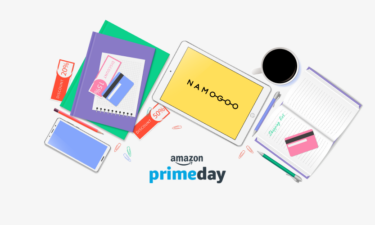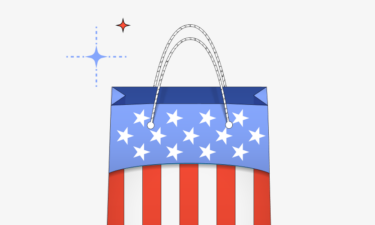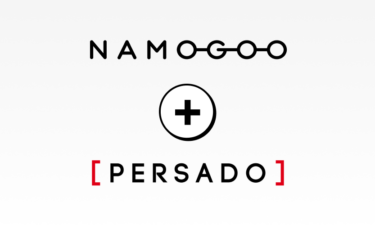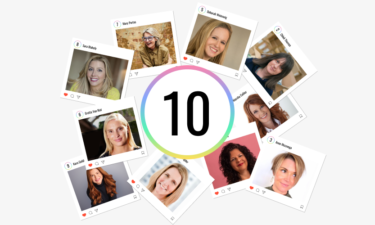In the eCommerce world, the holiday season that culminates in Christmas and New Year are the last opportunities to make it big and boost sales before the year ends. While many try to connect with shoppers with festive marketing strategies, only a few succeed.
With this guide, your brand can be one of the few who will celebrate the start of next year with a healthy bottom line and delighted customers. Keep reading to discover:
- Stats and insights into holiday shopping trends to inform your marketing strategies.
- 20+ ideas from a variety of brands including Target, BarkBox, Ashley Homestore, Dior, Walmart, Harry’s, Pottery Barn, and more.
- Actionable tips for an eventful and frictionless shopping experience that your customers will love and remember.
Let’s begin!
A Peak Into the 2022 Holiday Season
Retail is amid an all-time high shopping season—and you don’t want to miss it. Deloitte projects growth from 12.8% to 14.3% of holiday retail sales spending this year compared to the same holiday period a year ago[*]. This translates to record sales hitting between $1.45 to $1.47 trillion from November to January, of which $260 billion will be eCommerce holiday sales. While the numbers do not seem as optimistic compared to 2021, shoppers will continue to spend and inflation will raise dollar sales.
Who’s the 2022 Holiday Shopper?
Suffice to say, the 2022 Christmas and New Year period is not only exciting for brands and retailers but also competitive. With 91% of consumers planning to celebrate the winter holidays [*], how do you ensure that your strategies capture and increase your customer’s wallet share? It’s important to know what makes your audience tick right at this moment.
Here’s what we know about this year’s holiday shoppers according to McKinsey & Co.[*]:
- 55% say they are excited about holiday shopping.
- Nearly 40% of consumers, mostly millennials and Gen Zers, say they intend to splurge for themselves or others.
- 56% have already started shopping in October instead of waiting until later in the season.
- 50% of early shoppers have concerns about prices and product availability as the holidays get nearer.
- At least half say they would switch stores if they found a better price elsewhere.
As we expect the growing trend to continue this year, let’s examine the following exclusive data on conversion rates (CVR) per industry during the holiday season in 2020 and 2021. Gifts and flowers had impressive growth during the period, with a 63.56% YoY CVR change. It’s one of only three industries that had positive CVR growth, along with Health and Computer Electronics & Technology.
Top Holiday Strategies for A Memorable and Festive Shopping Experience
With so much at stake, now is the time for brands and retailers to prepare—if you haven’t already—and optimize holiday strategies. Here are 23 tips for maximizing your opportunities to delight and win customers this season.
Make Shopping Stress-free with Meaningful Content
The meaning of holiday rush depends on whom you ask. Some shoppers enjoy the thrill of hunting for the perfect gift. While others find buying Christmas presents stressful. To deliver holiday buying journeys that stick, you must be prepared to cater to all types of shoppers this season of giving.
1. Create Comprehensive Gift Guides
Online shoppers, without a doubt, have endless choices of gifts to choose from. Considering how busy the end of the year can get, looking for the right present for people who matter to them can be a daunting task. You can make gift-shopping feel like a walk in the park with a selection of gift guides that cater to different personas your customers might be shopping for.
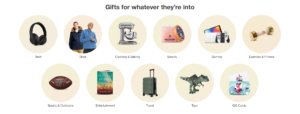
Image credit: Target
For a huge retailer like Target, gift guides are crucial to lead shoppers to products that match what they have in mind. So, the retailer crafted not just ordinary gift guides that highlight best sellers or exclusive holiday items, but also nuanced ones that depend on hobbies, recipients, and price points.
2. Speak to Shoppers’ Emotions
Emotions are heightened during Christmas and New Year. With 95% of purchasing decisions driven by emotions[*], it’s no wonder that holiday ads are almost always relatable and effective in generating a response from shoppers. With inspirational videos, persuasive copy, or user-generated content (UGC), you can set up emotion-driven campaigns that highlight the values that are important to your customers.

Image credit: The Warehouse
3. Make Content Shoppable
Have creative content, such as videos and images, to include in your holiday promotions? Make sure customers can find the products that you featured. This is already common on social media platforms, allowing users to seamlessly buy products right on the app. On your site, you can have a dedicated collection or page that contains promoted products for customers who are visiting from one of your ads. You can even take this a step further and engage with customers as they shop in real-time with live streaming.
Sosandar captures consumer attention through eye-catching apparel in their adverts, which are then made available through their website. The brand has a dedicated page called “Shop the TV Ad” so that customers can go from watching to shopping in under a minute.
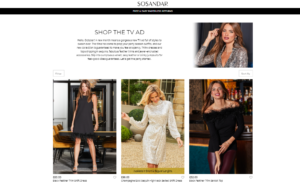
Image credit: Sosandar
4. Build an email campaign worth looking forward to
Don’t forget about your email list. You don’t have to wait for customers to come to your site; you can engage them this festive season by delivering relevant content to their inboxes. In addition to holiday-themed content, you can personalize your emails by highlighting items shoppers had on their wishlists with a promo code, or cherry-picked products based on their user behavior. As holiday consumers shop in an omnichannel way, this strategy can be more effective if you also send personalized SMS.
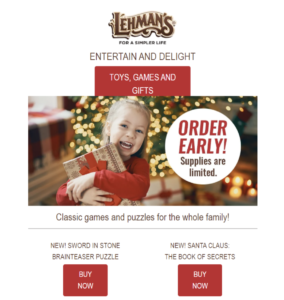
Image credit: Lehman’s
For Christmas, Lehman’s is building anticipation for the season with emails sent as early as November. There are messages for almost every category, including toys, home decor, and garden tools. Lehman’s also encourages early shopping to ensure that customers can get the products that they want while supplies last.
Be Generous with Freebies and Unique Offers
Of course, holiday marketing campaigns wouldn’t be complete without promotions, and even more so as the ongoing pandemic and inflation continue to push more people to actively look for deals. An overwhelming majority of consumers, at 88%, are planning to look for more discounts and offers during their holiday shopping.[*] Inflation or not, however, who doesn’t want to score money-saving discounts? After all, multiple studies show that positive feelings come after customers snag a great deal.
5. Give Discounts Based on Intent
What are shoppers looking at on your site? Which phase of the customer journey are they in now? Naturally, brands and retailers are competing for your customers’ attention with appealing promos. So, to stand out, make sure that your offers are highly relevant by delivering promotions based on your shoppers’ intent and where they are in the customer journey.
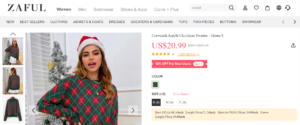
Image credit: Zaful
Zaful offers a variety of promotions for a diverse set of users that could be shopping on their site. They have unique offers for new customers, returning shoppers, and mobile users, and a tiered discount scheme to cater to different spending habits.
6. Bundle Orders to Highlight Savings
Bundling orders hit two birds with one stone. First, customers can get more items at a discounted price. Second, you’re providing them with a compelling reason, or in this case, offer, to complete a purchase with more products.
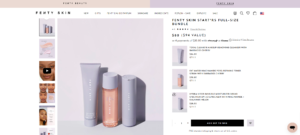
Image credit: Fenty Beauty
Fenty Beauty, for example, has exclusive bundles for customers who want to get more for their dollar. For customers who are looking to maximize their money, this is a great deal. They can gift the items separately or keep them all. The brand also highlights just how much is saved by opting for the bundle.
7. Experiment with Unique Offers Placement
Have you ever seen the same ads or banners so many times that you just ignore them? Banner blindness is a thing that brands need to constantly consider when planning new marketing campaigns. To prevent this from happening, you can experiment with a new creative layout, a different way of delivering promo codes to shoppers, or a unique location for offers on your site.
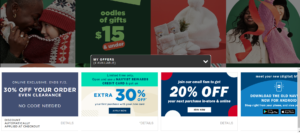
Image credit: Old Navy
Instead of distracting users with multiple in-line banners, Old Navy hid all promotions in a sticky popup menu that shoppers can open at their own pace. The discount menu is labeled “My Offers” which gives it a more personal feel. Its homepage is also filled with gifting ideas for every budget.
Prevent Shopping Cart Abandonment
One of the most frustrating things and essentially a low-hanging fruit for many brands is shopping cart abandonment. About 69% of online shoppers leave their carts just a few steps away from completing a purchase. While many reasons might be out of your control, there are several ways for you to try to turn your shoppers’ high intent to purchase into sales.
8. Be Transparent About Shipping Cost
It’s a common scenario. Customers are shopping to their hearts’ content and when the time comes to pay—and this is after they sign up and input their shipment details—they’re completely shocked by the amount of shipping fee. So, they abandon the shopping cart. Don’t let this happen to your brand. Always keep shoppers in the loop about the total amount they’re going to pay in the end.
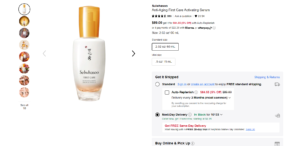
Image credit: Sephora
Sephora is clear about where the product is headed and how much the shipping cost is. This removes uncertainty and boosts shoppers’ confidence in their chosen products. The retailer also encourages membership by offering free shipping to anyone signing up.
9. Add More Ways to Checkout
Keeping the checkout process as clean and simple as possible is one of the surest ways to prevent shopping cart abandonment. In addition to allowing guest checkout, you can also present multiple options for customers to get their hands on your products.
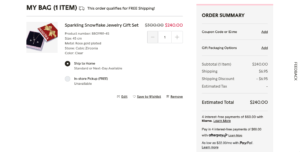
Image credit: Pandora
Pandora allows shoppers to add a promo code and choose the type of fulfillment that they’re comfortable with. Moreover, the brand also adds extra value with gift packaging options and several payment options that provide customers not only with choice but also convenience.
10. Include an Exit Popup
An exit popup is a common, and often the final opportunity, to encourage shoppers to stay on your site and buy. Besides the usual discount, you can get creative by communicating the actual value that customers will get at that exact moment should they choose to go back and complete the purchase.
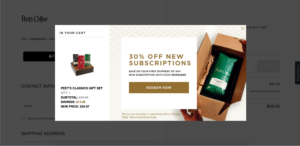
Image credit: Peet’s Coffee
Peet’s Coffee’s exit popup is no ordinary exit popup. In addition to the huge discount for new customers, they include a snapshot of the users’ shopping cart. Applying context in the promotion, Peet’s Coffee illustrates the savings and final amount that shoppers could get.
Increase Average Order Value
Holiday shopping is often a planned activity. Customers do set aside budgets just for this time of the year. You can increase your share of the market by inspiring impulsive purchases that are founded on adding more value to shoppers.
11. Offer to Buy and Claim Gift Card
Gift cards are straightforward, easy, and less wasteful than gifting something that recipients wouldn’t end up using. Moreover, a study found that consumers spend more than the gift card value which is great news for brands[*]. Make sure you offer this option to your shoppers. You can place it on the menu for quick access. The shopping cart is also a strategic location for last-minute purchase decisions.
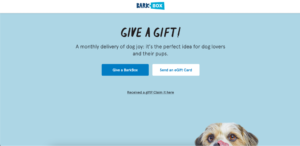
Image credit: BarkBox
On BarkBox’s homepage, the hero image features gift cards that shoppers can buy or claim. When shoppers start the buying process, the brand welcomes them with a form to ensure that the gift card is personalized according to the receiver’s details.
12. Recommend Complementary Products
Users will show interest in products related to the items they’re viewing as long as there’s relevance and added value. For instance, checking out pillows can have shoppers also looking at pillowcases, beddings, and bedroom furniture.
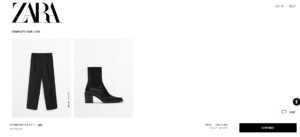
Image credit: Zara
You can boost last-minute add-to-cart items by having a recommendation carousel on your shopping cart – Zara suggests items to complete the look. Product suggestions, like offers, are more effective if they are based on current intent. So, it’s crucial to understand and act according to your customers’ current context.
13. Set an Accessible Shipping Threshold
The holidays could be the only time when expedited shipping is common, particularly for gift-shopping procrastinators, but it’s no surprise that 82% of shoppers prefer free shipping to paying extra for faster shipping[*]. You can offer the same by allowing shoppers to purchase items with a certain total amount to pay no shipping charges.
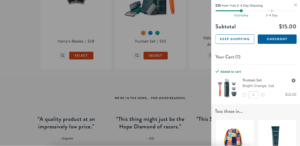
Image credit: Harry’s
Harry’s takes it a step further. The brand offers a tiered shipping arrangement that can combine free and faster shipping. They make it clear on the shopping cart that customers can get expedited shipping without an extra charge once they reach a minimum amount.
Create Excitement and Urgency
Limited deals are not only for Black Friday and Cyber Monday. You can replicate the same sense of urgency by focusing your effort on the right types of customers. Who would be most attracted and excited to avail of exclusive and time-based discounts? Think of bargain hunters, last-minute shoppers, and customers on a budget.
14. Set Up Countdowns for On-Sale Items
Having time-sensitive promotions on-site can boost conversions. To make this Christmas and New Year strategy successful, you must ensure that the discounted items up for grabs are relevant to the season.
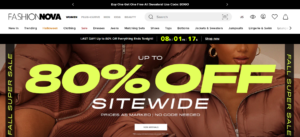
Image credit: Fashion Nova
For instance, Fashion Nova’s sale countdown is timely and relevant. Going to parties, family gatherings, or reunions? Shoppers are on the hunt for the perfect outfit for these festive occasions.
15. Release Limited/Holiday Exclusive Products
Another popular holiday marketing strategy is to launch exclusive products. You can use this tactic to re-engage existing customers, spur conversions within your community of loyal shoppers, or simply boost engagement and visits to your site.
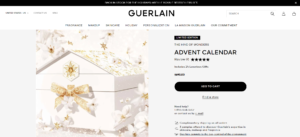
Image credit: Guerlain
Guerlain released an advent calendar that combines their fragrance, skincare, and home products. The purchase contains sample-size items that can encourage new customers to try out several of the luxury brand’s products in one purchase. They also come in exclusive, limited edition packaging with featured art from illustrator Aleksandra Miletić.
16. Communicate Order and Shipping Deadlines
Managing logistics during the holiday rush is a challenge for both brands and customers. With a reminder about your shipping schedule, you not only prompt shoppers to complete their purchases on time, but also ensure a positive customer experience by managing their expectations.
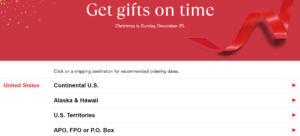
Image credit: Macy’s
On their website, Macy’s encourages customers to shop early so that items could be shipped in time for Christmas. The retailer also has a dedicated page to help set expectations on delivery time for holiday purchases.
Be Active on Social and Community
Finally, a list of holiday marketing strategies wouldn’t be complete without a section on ramping up social and community engagement. Social media platforms—where you’ll find many of your customers—are critical touchpoints that shouldn’t be missed during the season of gifting.
17. Feature UGC as Social Proof
As shoppers research your products, reviews, recommendations, or feedback from fellow customers are essential sources of trust and confidence. By featuring UGC on your site, you can make your brand more accessible and relatable to new and current customers. You can put it on site pages that will help shoppers in their decision-making process or product discovery phase such as product detail pages and the homepage.
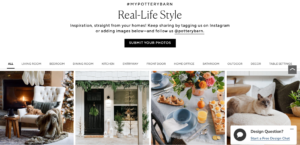
Image credit: Pottery Barn
Pottery Barn has a dedicated landing page for UGC. Site browsers can explore these images for inspiration. On social, the brand benefits from organic engagement as customers mention or tag their account. You can inspire genuine conversions with shoppers by doing something similar.
18. Create Contests to Boost Organic Engagement
Another way to boost conversations and create buzz on social media is by creating contests. You can implement it in a way that requires participants to post UGC, tag their friends and family, and/or comment on your posts.
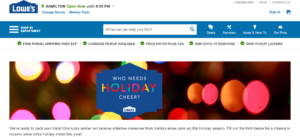
Image credit: Lowe’s
Lowe’s has year-long contests that change based on the celebrations of the time. Ahead of the winter holidays, the brand launched a contest for some holiday cheer that will have a lucky winner receive a festive makeover.
19. Collaborate with Content Creators/Influencers
Planning to extend your reach to more audiences or new markets? Partnering up with influencers could be a good idea. The key here is to choose content creators wisely. Depending on your brand values, you can collaborate with those who are truly engaged and connected with their community.
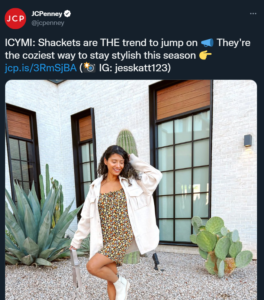
Image credit: JCPenney
JCPenney regularly features content creators wearing brand apparel on its social media accounts. More than style inspiration, the posts also have direct links to the product pages so that customers can purchase the items in a few clicks.
Bonus: Get Inspired by These 4 Christmas and New Year’s Marketing Campaigns 2022
Let’s learn from more holiday marketing strategies, shall we? The following are extended examples of thematic campaigns from big retailers.
1. Nordstrom Rack’s “Rack Up The Merry” [*]
Nordstrom Rack started early in their holiday campaign, encouraging customers to find the perfect gifts in October and save through great deals – definitely appealing to the price-sensitive shoppers concerned about inflation this year. Besides a video commercial enticing shoppers to “rack up the deals”, the retailer has also been ahead in its website already geared for holiday shopping and timely emails.

Image credit: Nordstrom Rack
2. Walmart’s “Holidays: All the Things We Need”[*]
For 2022, Walmart’s holiday ad recognizes that there is no one way to celebrate the season. Households can be decorated with Christmas, Hanukkah, or Kwanzaa decor. No matter how shoppers celebrate, Walmart promises that everything they need for their annual traditions can be found in their stores.
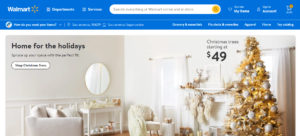
Image credit: Walmart
3. Levi’s “Give Better”[*]
More consumers are realizing the negative impact of fast fashion. As a result, brands are slowly making changes to adopt more sustainable practices. This is what Levi’s highlights in their 2022 Christmas and New Year campaign, an extension of their theme last year. On Levi’s site, the brand promotes clothing and gifting tips that champion sustainability, and categorizes them based on the intended recipient. Levi’s also educates shoppers about the concept while sharing information about what they’re doing to contribute to the cause.
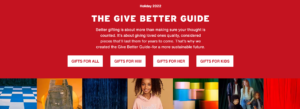
Image credit: Levi’s
4. Swarovski’s “Open the Holiday” [*]
The season is magical – the jewelry brand encourages customers to make their own magic with Swarovski crystals. International supermodel Bella Hadid is the face of the campaign, playing as the holiday fairy exploring the crystals and colors in a Swarovski box. While the brand’s accessories are the most highlighted, the holiday celebration also sees the introduction of a new advent calendar, collectible characters, and home decor.
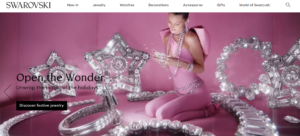
Image credit: Swarovski
Are You Ready to Deliver Shopping Moments Filled with Relevance and Cheer?
At least 19% of annual retail sales happen during the holiday season[*]. For some brands, it’s even higher. So, how could you increase the percentage of your holiday sales this year?
First, you can implement any of the marketing strategies presented above. Second, and this is equally important, is to have an overall approach that focuses on helping shoppers to beat the holiday rush and shop stress-free. This means personalizing the customer journey from the unique offers that you deliver to the small tweaks that remove barriers to a festive shopping experience.
It’s not too late to craft holiday experiences worth coming back for. Act now and you’ll reap the benefits of delivering seamless and customer-first shopping journeys as you ring in 2023.




